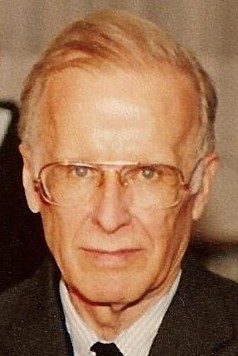In computer science, an abstract data type (ADT) is a mathematical model for data types, defined by its behavior (semantics) from the point of view of a user of the data, specifically in terms of possible values, possible operations on data of this type, and the behavior of these operations. This mathematical model contrasts with data structures, which are concrete representations of data, and are the point of view of an implementer, not a user. For example, a stack has push/pop operations that follow a Last-In-First-Out rule, and can be concretely implemented using either a list or an array. Another example is a set which stores values, without any particular order, and no repeated values. Values themselves are not retrieved from sets, rather one tests a value for membership to obtain a Boolean "in" or "not in".
In mathematics and computer science, currying is the technique of translating a function that takes multiple arguments into a sequence of families of functions, each taking a single argument.
In computer science, functional programming is a programming paradigm where programs are constructed by applying and composing functions. It is a declarative programming paradigm in which function definitions are trees of expressions that map values to other values, rather than a sequence of imperative statements which update the running state of the program.
Lambda calculus is a formal system in mathematical logic for expressing computation based on function abstraction and application using variable binding and substitution. It is a universal model of computation that can be used to simulate any Turing machine. It was introduced by the mathematician Alonzo Church in the 1930s as part of his research into the foundations of mathematics.

A programming language is a system of notation for writing computer programs.

John Warner Backus was an American computer scientist. He led the team that invented and implemented FORTRAN, the first widely used high-level programming language, and was the inventor of the Backus–Naur form (BNF), a widely used notation to define syntaxes of formal languages. He later did research into the function-level programming paradigm, presenting his findings in his influential 1977 Turing Award lecture "Can Programming Be Liberated from the von Neumann Style?"
In computer science, declarative programming is a programming paradigm—a style of building the structure and elements of computer programs—that expresses the logic of a computation without describing its control flow.
ISWIM is an abstract computer programming language devised by Peter Landin and first described in his article "The Next 700 Programming Languages", published in the Communications of the ACM in 1966.
In programming language theory, semantics is the rigorous mathematical study of the meaning of programming languages. Semantics assigns computational meaning to valid strings in a programming language syntax. It is closely related to, and often crosses over with, the semantics of mathematical proofs.
In mathematics, an expression or mathematical expression is a finite combination of symbols that is well-formed according to rules that depend on the context. Mathematical symbols can designate numbers (constants), variables, operations, functions, brackets, punctuation, and grouping to help determine order of operations and other aspects of logical syntax.
The Joy programming language in computer science is a purely functional programming language that was produced by Manfred von Thun of La Trobe University in Melbourne, Australia. Joy is based on composition of functions rather than lambda calculus. It has turned out to have many similarities to Forth, due not to design but to an independent evolution and convergence. It was also inspired by the function-level programming style of John Backus's FP.
A von Neumann language in computing is a programming language that is a high-level abstract isomorphic copy of a von Neumann architecture. As of 2009, most current programming languages fit into this description, likely as a consequence of the extensive domination of the von Neumann computer architecture during the past 50 years.
Value-level programming refers to one of the two contrasting programming paradigms identified by John Backus in his work on programs as mathematical objects, the other being function-level programming. Backus originally used the term object-level programming but that term is now prone to confusion with object-oriented programming.
FP is a programming language created by John Backus to support the function-level programming paradigm. It allows building programs from a set of generally useful primitives and avoiding named variables. It was heavily influenced by APL developed by Kenneth E. Iverson in the early 1960s.
In the classification of programming languages, an applicative programming language is built out of functions applied to arguments. Applicative languages are functional, and applicative is often used as a synonym for functional. However, concatenative languages can be functional, while not being applicative.

Programming language theory (PLT) is a branch of computer science that deals with the design, implementation, analysis, characterization, and classification of formal languages known as programming languages. Programming language theory is closely related to other fields including mathematics, software engineering, and linguistics. There are a number of academic conferences and journals in the area.
FAUST is a domain-specific purely functional programming language for implementing signal processing algorithms in the form of libraries, audio plug-ins, or standalone applications. A FAUST program denotes a signal processor: a mathematical function that is applied to some input signal and then fed out.
In programming language semantics, normalisation by evaluation (NBE) is a method of obtaining the normal form of terms in the λ-calculus by appealing to their denotational semantics. A term is first interpreted into a denotational model of the λ-term structure, and then a canonical (β-normal and η-long) representative is extracted by reifying the denotation. Such an essentially semantic, reduction-free, approach differs from the more traditional syntactic, reduction-based, description of normalisation as reductions in a term rewrite system where β-reductions are allowed deep inside λ-terms.
A CEK Machine is an abstract machine invented by Matthias Felleisen and Daniel P. Friedman that implements left-to-right call by value. It is generally implemented as an interpreter for functional programming languages, but can also be used to implement simple imperative programming languages. A state in a CEK machine includes a control statement, environment and continuation. The control statement is the term being evaluated at that moment, the environment is (usually) a map from variable names to values, and the continuation stores another state, or a special halt case. It is a simplified form of another abstract machine called the SECD machine.


